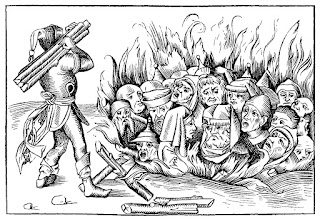Evil Decree of Uman, 1768
20 June, 1768
Uman, Ukraine
Uman was where my great-grandparents, Isaac Wexelman and Libby Gerber, were married, before coming to Canada.
On the heals of the 17th century Chmielnicki Massacres, a series of pogroms took place in Eastern Europe, known as the Haidamak rebellions. Disenfranchised cossacks and peasants attacked Jewish communities (as well as Poles), killing hundreds of thousands.
The Ukrainian commanders, Maksym Zalizniak, openly encouraged the slaughter of Jews and Poles in the open countryside, so people from all around crowded into the fortified city of Uman. Zalizniak's army set up a siege, but after only three days the city fell when the city commander, Ivan Gonta, switched sides. The Jews fled to the synagogues and attempted to defend themselves. However, the Ukrainians were armed with cannons and obliterated the defenses and then killed those inside.
Four years after this took place, Rabbi Nachman of Breslav was born. He is famously buried in Uman, where he spent only the last six months of his life. The mass grave of Jews from 1768 is supposedly what drew Rabbi Nachman of Breslav to the city of Uman. (Breslav.co.il) While his grave has made Uman a destination, the story behind his decision to be buried there is far less known.
Uman, Ukraine
Uman was where my great-grandparents, Isaac Wexelman and Libby Gerber, were married, before coming to Canada.
On the heals of the 17th century Chmielnicki Massacres, a series of pogroms took place in Eastern Europe, known as the Haidamak rebellions. Disenfranchised cossacks and peasants attacked Jewish communities (as well as Poles), killing hundreds of thousands.
The Ukrainian commanders, Maksym Zalizniak, openly encouraged the slaughter of Jews and Poles in the open countryside, so people from all around crowded into the fortified city of Uman. Zalizniak's army set up a siege, but after only three days the city fell when the city commander, Ivan Gonta, switched sides. The Jews fled to the synagogues and attempted to defend themselves. However, the Ukrainians were armed with cannons and obliterated the defenses and then killed those inside.
"During the carnage, many Jews fled to the main synagogue. There, they armed themselves and put up a stiff defense. Rabbi Leibish, with sword in hand, had managed to kill twenty of the enemy. Rabbi Moshe Menaker also killed several. Seeing that the Jews could not be defeated, the Haidamaks sealed off the synagogue perimeter, brought a canon and fired, blasting its walls as they three themselves upon the many who had taken refuge there." (Israel National News, and Jewish Encylopedia based on The Sword of Gonta)The fifth of Tamuz was declared a fast day to mark this horrific massacre. (Simon Bernfeld, Sefer Hademaot) It is unclear how widely this fast day was kept, but declaring a fast was a normal Jewish response to Jewish massacres. Rabbi David Hazzan composed a kinah for to be recited on this day.
Four years after this took place, Rabbi Nachman of Breslav was born. He is famously buried in Uman, where he spent only the last six months of his life. The mass grave of Jews from 1768 is supposedly what drew Rabbi Nachman of Breslav to the city of Uman. (Breslav.co.il) While his grave has made Uman a destination, the story behind his decision to be buried there is far less known.
 |
| "The burning of Uman and the massacre of its people are described as a descent into madness" illustration from Shevchekno Poem |


Comments
Post a Comment